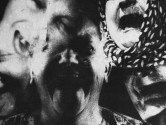



Decadent Shadows. The Cinema of Weimar Germany
The Weimar Era, the brief interwar period in Germany that extends from roughly 1919 to 1933 and that marks the lifespan of the fledging Weimar Republic, resulted in an extraordinary and prolific flowering of German cinema. Certain distinct characteristics of German society at the time – a pronounced sexual, artistic and social freedom coupled with the tortured aftermath of WWI, which left the German people physically and psychologically wounded and the country in economic straits – combined to produce a unique and specific cinema that straddled the silent and early sound eras. A period of great political and economic instability – of rampant inflation and unemployment – the Weimar Era was nonetheless also a time of important and all-encompassing cultural revival. Theater, music, art and architecture all flourished, with film uniquely positioned to reap the benefits of simultaneous technical achievement and artistic innovation.
A remarkable confluence of talent and opportunity characterizes Weimar cinema. Ufa, the state-run film studio, oversaw nearly all of the films during this period, with producer Erich Pommer shepherding such important films as The Cabinet of Dr. Caligari and Metropolis, among dozens of others. Many of the directors and writers who would flee from Germany to Hollywood when the Nazis rose to power made their first, groundbreaking films here – F.W. Murnau, Fritz Lang, William Dieterle, Robert Siodmak, Edgar G. Ulmer, Billy Wilder and cinematographer Karl Freund among them. Their stylistic and technical innovations were profoundly influenced by the political turmoil of the time, most notably the emergence of Expressionism as a style, characterized by deeply shadowed lighting, distorted perspective and intentionally artificial sets.
Weimar cinema reflected the uncertainties and concerns of the era, articulating the ideas of a cultural moment that would come to be recognized as a hugely influential period in film history. These works are defined by the depiction of decadent nightlife, a previously unseen eroticism and unfettered sexuality – particularly in women – whose seeming sense of freedom was undercut by a vein of hopelessness that ran just below the surface, threatening to overwhelm everyone in its path. In his book on Weimar culture, Peter Gay called this attitude “a dance at the edge of a volcano,” summarizing the prevailing mood whose dark side showed itself through depictions of unrequited or thwarted love, uncontrollable criminal activity and a clash between classes and generations. Central tropes emerge in film after film – the idea of the urban environment, represented in a series of “street” films, as simultaneously threatening and enticing in its debauchery, the figure of the immature man-child fatally incapable of taking control, the emasculated male, often embodied by the brilliant actor Emil Jannings and that of the fallen woman, representing either a trap for the unsuspecting, respectable male or the victim of a ruthless society. The films in this series represent Weimar cinema at its most exciting, showcasing both well-known works by acknowledged masters such as Murnau’s The Last Laugh, Lang’s Die Nibelungen and Dr. Mabuse, the Gambler, and Pabst’s The Joyless Street and Westfront 1918 along with lesser-known but equally important films as Asphalt, Whither Germany? and New Year’s Eve.


















